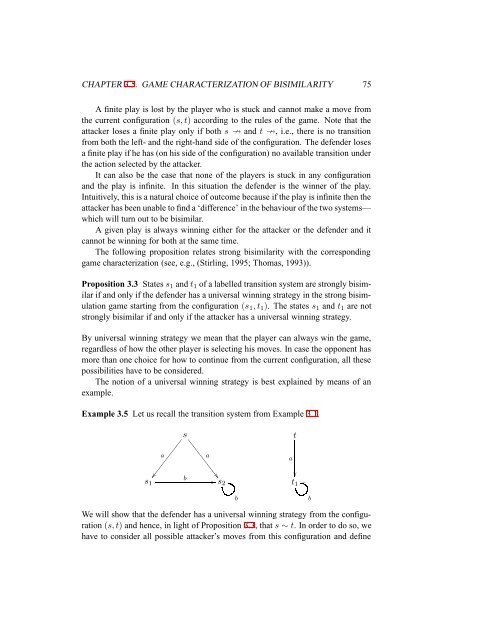Reactive Systems: Modelling, Specification and Verification - Cs.ioc.ee
Reactive Systems: Modelling, Specification and Verification - Cs.ioc.ee
Reactive Systems: Modelling, Specification and Verification - Cs.ioc.ee
You also want an ePaper? Increase the reach of your titles
YUMPU automatically turns print PDFs into web optimized ePapers that Google loves.
CHAPTER 3.5. GAME CHARACTERIZATION OF BISIMILARITY 75<br />
A finite play is lost by the player who is stuck <strong>and</strong> cannot make a move from<br />
the current configuration (s, t) according to the rules of the game. Note that the<br />
attacker loses a finite play only if both s <strong>and</strong> t , i.e., there is no transition<br />
from both the left- <strong>and</strong> the right-h<strong>and</strong> side of the configuration. The defender loses<br />
a finite play if he has (on his side of the configuration) no available transition under<br />
the action selected by the attacker.<br />
It can also be the case that none of the players is stuck in any configuration<br />
<strong>and</strong> the play is infinite. In this situation the defender is the winner of the play.<br />
Intuitively, this is a natural choice of outcome because if the play is infinite then the<br />
attacker has b<strong>ee</strong>n unable to find a ‘difference’ in the behaviour of the two systems—<br />
which will turn out to be bisimilar.<br />
A given play is always winning either for the attacker or the defender <strong>and</strong> it<br />
cannot be winning for both at the same time.<br />
The following proposition relates strong bisimilarity with the corresponding<br />
game characterization (s<strong>ee</strong>, e.g., (Stirling, 1995; Thomas, 1993)).<br />
Proposition 3.3 States s1 <strong>and</strong> t1 of a labelled transition system are strongly bisimilar<br />
if <strong>and</strong> only if the defender has a universal winning strategy in the strong bisimulation<br />
game starting from the configuration (s1, t1). The states s1 <strong>and</strong> t1 are not<br />
strongly bisimilar if <strong>and</strong> only if the attacker has a universal winning strategy.<br />
By universal winning strategy we mean that the player can always win the game,<br />
regardless of how the other player is selecting his moves. In case the opponent has<br />
more than one choice for how to continue from the current configuration, all these<br />
possibilities have to be considered.<br />
The notion of a universal winning strategy is best explained by means of an<br />
example.<br />
Example 3.5 Let us recall the transition system from Example 3.1.<br />
s<br />
a<br />
<br />
<br />
t<br />
<br />
a<br />
<br />
a<br />
<br />
<br />
<br />
b<br />
s1<br />
<br />
s2 <br />
t1 <br />
We will show that the defender has a universal winning strategy from the configuration<br />
(s, t) <strong>and</strong> hence, in light of Proposition 3.3, that s ∼ t. In order to do so, we<br />
have to consider all possible attacker’s moves from this configuration <strong>and</strong> define<br />
b<br />
b
















